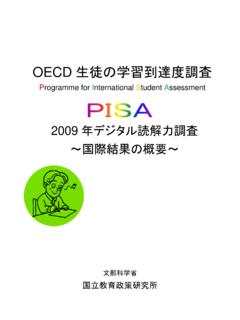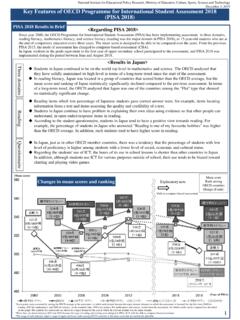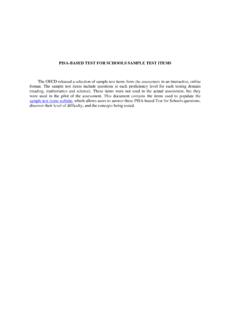Transcription of Chapter 9 Impedance Matching of Power Amplifiers …
1 RF Electronics Chapter 9: Impedance Matching of Power Amplifiers Page 1 2002-2009, C. J. Kikkert, through AWR Corp. Chapter 9 Impedance Matching of Power Amplifiers Introduction In order to obtain the most Power from a bipolar or field effect transistor, the input and output impedances of the device must be matched to that of the circuit in which it is placed. Similarly if an antenna is to be driven effectively, the antenna needs to be matched. For the maximum Power transfer, the source Impedance and the load Impedance must be a conjugate match, that is the resistive parts must be the same and the imaginary parts must be the same magnitude but opposite polarity. There are three basic types of Matching : Transformer Matching : RF Transformers can be used to produce very wideband Impedance Matching . The main limitations are the restricted range of available impedances (due to the turns-ratios being limited) and the frequency limitations on transformers.
2 LC Matching : where inductors and capacitors are used to effect the Impedance transformation. LC Matching results in a relatively narrow bandwidth match. LC Matching is very practical at frequencies from 30 MHz to 300 MHz. LC Matching permits easy tuning of the match to allow for device variations. Transmission line Matching : By using a transmission line of a required length and Characteristic Impedance , the required composite match can be obtained. Such a match tends to be of a broader frequency range than LC Matching and can be applied at frequencies above about 150 MHz. It is difficult to tune the length and characteristic Impedance of a transmission line once constructed. For each application, each of the above Matching techniques must be evaluated against the design criteria and the most appropriate technique selected. Choice of Components and Q value It is very important that the value of capacitors and inductors used be measured at the operating frequency.
3 Many capacitors are not suitable for RF applications, as their self resonance frequency is below the required operating frequency. For Power applications, inductors with ferrite cores may not be suitable as their losses may be too high. For a simple parallel tuned network, like the Pi network, the circulating current in a resonator is approximately Q times the external load current. For a 50 Watt amplifier, driving a 50 load a Q of 10 the current circulating in the Pi network is thus of the order of 10 Amps. This can cause significant heating and failure of the components. For some networks like both the T networks and the Bandpass L network, very high voltages can be experienced at some nodes and this can lead to voltage breakdown of components. The higher the Q the higher the stress on the components. A high Q value can also cause the Matching network to drift out of match is the components change due to temperature.
4 In general a Q value as low as possible is desirable, as this will give the widest bandwidth match and the lowest component stress. If the network is to be used as an output Matching network of an amplifier and harmonics are to be filtered as well, RF Electronics Chapter 9: Impedance Matching of Power Amplifiers Page 2 2002-2009, C. J. Kikkert, through AWR Corp. a higher Q value should be considered, since the higher the Q, the higher the attenuation at the amplifier harmonics. Since the current and voltage limits in the output Matching networks are very important, a trade-off between the Q value and Number for filter sections required to achieve the required harmonic attenuation may need to be considered. Large Signal Parameters: The large signal input and output impedances and the large signal S parameters are very different from the small signal impedances and small signal S parameters. The large signal parameters should be used in the design.
5 LC Matching In LC Matching Inductors and Capacitors are used to obtain the required conjugate Impedance match. The equations for calculating the components required are contained in Motorola Application note 267. LC Matching is very practical for Power Amplifiers from 30 to 300 MHz. A good indication of the suitability of LC Matching for a transistor is by noting the test circuits used by the manufacturers for the proposed device. Because it is easy to tune the Matching network using variable capacitors, these LC Matching networks are normally used by the manufacturers to determine the input and output Impedance of the devices. The device is placed in a test jig and the Matching network is adjusted to obtain the required output Power at a good efficiency and with a low input return loss. The values of the resulting LC Matching components are then used to determine the input and output Impedance of the device.
6 AN267 describes 4 Matching networks. In all the equations, the device Impedance is Rd+jXd and the load Impedance is RL. This notation is different from AN267, to avoid confusion between R1 and RL , particularly is a capital L is used. In the equations it is not assumed that the device is capacitive, so that Xd is used for the reactive part of the device Impedance , instead of Xcout. Also in AN267 for the Bandpass T and the Lowpass T networks, different expressions for A and B are used. In these notes consistent expression for A and B are used. Pi Network Figure 1. Pi Matching Network. CAPC=ID=C1 pFC1 CAPC=ID=C2 pFC2 INDL=ID=L1 nHL1 PORTZ=P=Xdevice Ohm1 PORTZ=P=Rload Ohm2 RF Electronics Chapter 9: Impedance Matching of Power Amplifiers Page 3 2002-2009, C. J. Kikkert, through AWR Corp. The Pi Matching network is very useful for Matching high Impedance sources to 50 loads. Pi Matching is normally used in valve Amplifiers .
7 For high Power solid-state devices, the Impedance values become impractical with very large capacitors and very small inductors being required. Figure 1 shows the Pi network used for Matching . To obtain the component values, firstly decide on a Q value for the Matching network. The Q value will effect the bandwidth, harmonic attenuation and component stress. For the Pi network, the input Impedance needs to be a parallel network, so that a series to parallel transformation may need to be applied before the network evaluation as shown in equation 1, which transforms the device Impedance of RD+jXD into RP in parallel with XP. The equations for the Pi network in AN267 assume that the device is resistive and that any reactive impedances are compensated for after the Pi network is designed. This also applies for the Visual Basic program included with these notes. The equations in the included MWO files handle reactive parts correctly.
8 The complete equations for the Pi Matching network are as follows: DDDpRXRR22 DDDpXXRX22 Eqn. 1 PPCCXRQXY1111 Eqn. 2 LPLPLCRRQRRRX )1(22 Eqn. 3 1)(22 QXRRQRXCLPPL Eqn. 4 Note that Q2 +1 must be larger than RP/RL for XC2 to be valid. Low Pass T Network Figure 2. T Matching Network. The Low pass T network is very good for use as an output Matching network for a Power amplifier stage, where the amplifier is to be connected to an antenna. Having a INDL=ID=L1 nHL1 INDL=ID=L2 nHL2 CAPC=ID=C1 pFC1 PORTZ=P=Xdevice Ohm1 PORTZ=P=Rload Ohm2 RF Electronics Chapter 9: Impedance Matching of Power Amplifiers Page 4 2002-2009, C. J. Kikkert, through AWR Corp. series inductor (L1) as the element connected to the device results in an open circuit to the second harmonic currents, resulting in a reduced current flow through the transistor and resulting in a higher efficiency.
9 However since the output voltage is more distorted a higher inter-modulation distortion may result. For more severe filtering of harmonics, a cascaded set of low pass Matching networks is desirable. The equations for the low pass T network are as follows: DDLXQRX 1 where RD+jXD is the device Impedance Eqn. 5 ARXLL 2 Eqn. 6 AQBXC 1 Eqn. 7 where 11)1(2 LLDRBRQRA Eqn. 8 )1(2 QRBD Eqn. 9 Note this network clearly shows that the Q used in the Matching network relates to the Impedance transformation ratio. The minimum Q occurs when A1=0, so that 1min DLRRQ Eqn. 10 Bandpass L network Figure 3. Bandpass L Matching Network. The bandpass L network is often used as test circuit by semiconductor manufacturers.
10 It has a DC block, to allow biasing to be set up for the input of transistors and to prevent any DC supply from appearing on the output of an amplifier stage. Normally C1 and C2 are adjustable, making it very easy to tune the amplifier for either a peak of output for an output Matching network or for the best input match for an input Matching network. CAPC=ID=C1 pFC1 CAPC=ID=C2 pFC2 INDL=ID=L2 nHL2 PORTZ=P=Xdevice Ohm1 PORTZ=P=Rload Ohm2 RF Electronics Chapter 9: Impedance Matching of Power Amplifiers Page 5 2002-2009, C. J. Kikkert, through AWR Corp. The equations for the band pass L network are as follows: DCQRX 1 where RD + jXD is the device Impedance Eqn. 11 dldlCRRRRX 2 Eqn. 12 212 CLDCLXRRXX Eqn. 13 The device Reactance XD is incorporated in either C2 for capacitive device impedances or into L2 for inductive device impedances.



